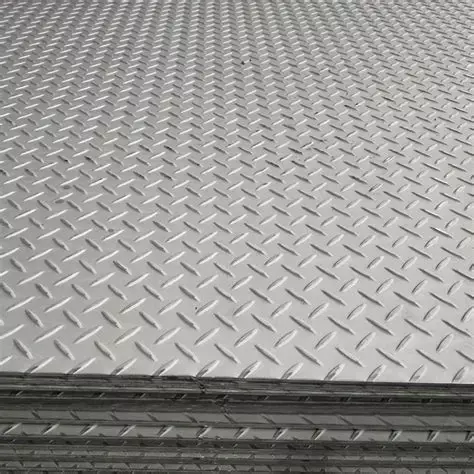A 4×8 (48"×96") sheet of carbon steel diamond (tread/checker) plate typically sells in the United States for about $130–$450 per full sheet when bought retail in common thicknesses (1/8" ≈ 0.125", 3/16", 1/4"), while stainless steel and aluminum diamond plate variants commonly cost significantly more (often 1.5×–3× the carbon-steel price), depending on alloy, finish, and quantity; final cost depends mainly on thickness, material (carbon vs. stainless vs. aluminum), market steel price, finish (galvanized, painted), and cutting/shipping services.
Quick price summary
-
Carbon (hot-rolled) diamond plate, 4'×8' (common): roughly $130–$450 per sheet (lower end for very thin 14–16 ga, higher end for 1/4" plate).
-
Aluminum diamond plate (4×8): often $200–$900 depending on alloy and thickness (thin decorative sheets at low end; 1/8"–1/4" structural 5052/6061 higher).
-
Stainless steel diamond plate (304/316): generally $500–$1,800+ per 4×8 sheet depending on gauge and finish.
Note: these ranges reflect typical retail/metal service center pricing in North America and are influenced by market steel/aluminum prices, local supplier markup, and whether you order single sheets or pallet quantities.

What “diamond plate” means
Common names: diamond plate, tread plate, checker plate, floor plate. The sheet has raised lugs (diamond or 1-bar/2-bar patterns) stamped or rolled onto one face to increase slip resistance and hide scratches. Steel variants are usually hot-rolled, raised pattern, A786/A36 family, while aluminum and stainless versions follow their respective alloy standards (ASTM B209 for aluminum, specialty specs for stainless forms).
Weight & handling — thickness → pounds per 4×8 sheet
Below is a practical table used by steel distributors and fabricators. weights vary slightly with pattern depth and alloy, but these are reliable planning figures.
| Thickness (imperial) | Weight per sq.ft. (approx.) | Weight — 4'×8' sheet (48×96) |
|---|---|---|
| 14 ga (≈0.078") | 3.75 lb/ft² | 120 lb |
| 1/8" (0.125") | 6.16 lb/ft² | ~197 lb |
| 3/16" (0.1875") | 8.70 lb/ft² | ~279 lb |
| 1/4" (0.250") | 11.25 lb/ft² | ~360 lb |
These figures come from standard weight tables used by floor-plate suppliers; always confirm with your vendor because pattern depth and alloy can change actual weight by a few percent. Use standard density formulas (width × length × thickness × density) for custom confirmation.
Typical retail price table for a 4×8 sheet
Prices below are illustrative ranges compiled from distributors and online stores for common, ready-stock items; bulk orders and mill direct purchases can be much lower per unit.
| Material / Thickness | Typical retail range (USD) — single sheet (4×8) |
|---|---|
| Carbon steel diamond plate — 14 ga (≈0.078") | $120 – $200 |
| Carbon steel — 1/8" | $130 – $240 |
| Carbon steel — 3/16" | $220 – $360 |
| Carbon steel — 1/4" | $300 – $550 |
| Aluminum — .025" (thin) | $70 – $180 (decorative, thin) |
| Aluminum — 1/8" | $260 – $520 |
| Aluminum — 1/4" | $600 – $1,000+ |
| Stainless (304/316) — 1/8" | $550 – $1,200+ |
Key takeaway: for most industrial floor/traction uses, carbon steel 1/8" or 3/16" is the cost-effective choice; aluminum is favored where corrosion resistance and lower weight matter; stainless is chosen for hygiene/corrosion-critical applications despite higher cost.
Why prices vary — the major cost drivers
-
Material type & alloy: Carbon steel is cheapest, aluminum next, stainless most costly because of alloying elements (nickel, chromium).
-
Thickness / gauge: thicker plates use more metal (and weigh more), so price scales roughly with weight (plus processing).
-
Pattern depth & finish: deeper lugs use more metal in rolling/stamping and may cost more; polished or anodized finishes increase price.
-
Market raw-material pricing: steel and aluminum commodity prices fluctuate with global supply/demand and tariffs. Local scrap/zinc/aluminum futures affect quoted retail.
-
Quantity and sourcing: single sheets carry retail markups; pallet or mill-direct buys reduce per-sheet cost substantially.
-
Cutting, shearing, shipping and LTL freight: heavy single 4×8 plates can trigger LTL freight, special handling, and lift equipment charges.
-
Certification / testing: if you need mill test reports or specific ASTM compliance certificates, expect small premiums.
Standards, specifications and authority
-
ASTM A786 — the common specification for hot-rolled steel floor plates (diamond/tread/checker plates). It covers mechanical properties and chemical limits for floor plate steels (yield, tensile, carbon limits).
-
ASTM B209 — the standard for aluminum sheet/plate; relevant when buying aluminum diamond plate.
-
For stainless, ask for alloy-specific data (e.g., 304/316 chemical & mechanical certification) and finish (hot-rolled annealed & pickled — HRAP — for stainless tread).
Procurement tip: request a mill test report (MTR) and confirm the stamped pattern and finish type in writing; if your application is structural or safety-critical, verify yield and tensile values.
How to calculate your project cost
-
Determine required material and thickness (which controls weight).
-
Calculate weight: use table in section 3 or compute: width (in) × length (in) × thickness (in) × density (lb/in³) = weight in lb. Common steel density ~0.283 lb/in³.
-
Get supplier price per sheet (or per lb) and add cutting/edge-debur/processing fees.
-
Add freight & LTL handling based on weight & destination. Heavy 4×8 sheets commonly trigger pallet/LTL charges.
-
Allow for scrap/fit-up loss (typically 5–10%) and for potential extra for specialized finishing (galvanizing, paint).
Example quick calc (carbon steel 1/8"): sheet ≈197 lb. If supplier sells at $0.80/lb → sheet ≈ $158; add $60 LTL → ~$218 delivered (numbers hypothetical — get quotes).
Material comparison
| Factor | Carbon steel diamond plate | Aluminum diamond plate | Stainless diamond plate |
|---|---|---|---|
| Cost (4×8, typical) | Lowest | Mid–high | Highest |
| Weight | Heaviest | Lightest | Mid (heavier than Al) |
| Corrosion resistance | Poor (needs coating/galv) | Excellent | Excellent (best in chemicals) |
| Weldability | Good (but carbon content matters) | Good (requires different technique) | More difficult, needs stainless practice |
| Common uses | Traction floors, ramps, truck decks | Vehicle trim, food trucks, RVs, weight-sensitive | Food processing, marine, chemical plants |
| Standards | ASTM A786/A36 | ASTM B209 | Alloy-specific (304/316), HRAP finish |
Fabrication, cutting, welding, and installation considerations
-
Cutting: plasma, oxy-fuel, or shearing are common; flame cutting may require edge grinding to remove distortion. Heavy plates need CNC plasma or oxy-fuel.
-
Welding: carbon floor plate welds like structural steel but watch carbon content (preheat may be needed on thick plates). Stainless welding requires gas shielding and post-weld cleaning to preserve appearance/corrosion resistance. Aluminum requires specific welders and filler rods.
-
Drilling & fastening: pre-drill if using bolts; use hardened bits for repeated holes in thick steel.
-
Handling: manual handling of 1/8"–1/4" 4×8 steel sheets requires two or more people or a lift — a 1/4" plate can weigh around 360 lb.
Corrosion protection & finishes
-
Black (hot-rolled) steel: cheapest; requires painting, powder coat, or galvanizing for outdoor/corrosive environments.
-
Galvanized: good for longer outdoor life; adds cost plus zinc is volatile in price.
-
Aluminum: naturally corrosion resistant; can be anodized for additional surface hardness/appearance.
-
Stainless: inherently corrosion resistant — choose 316 for marine/chemical exposure.
Where to buy & procurement tips
-
Local metal service centers / fabricators: ideal for quick pickup, cut-to-size service, and small orders.
-
Online metal distributors (retail): many list stock 4×8 sizes with immediate prices — good for price benchmarking.
-
Mill or wholesale: best for large volumes — request MTRs and negotiate freight.
-
Procurement checklist: ask for pattern (4-way, 1-bar), alloy & spec (ASTM A786, B209), mill test report, finish, exact thickness tolerance, cut tolerance, and delivery terms.
Quick checklist for procurement managers & installers
-
Confirm exact size (48×96 or custom).
-
Confirm thickness & pattern (1/8", 3/16", 1/4"; 4-way diamond or 1-bar).
-
Ask for MTR / spec compliance (ASTM A786 for steel; B209 for aluminum).
-
Confirm weight for freight planning (see section 3 table).
-
Check cutting/welding instructions with fabricator.
-
Get freight quotes (LTL) and factor into landed cost.
FAQs
1. How much does a 4×8 diamond plate weigh?
Depends on thickness. Typical weights: 14 ga ≈120 lb; 1/8" ≈197 lb; 3/16" ≈279 lb; 1/4" ≈360 lb for steel 4×8 sheets. Use supplier weight tables or the weight formula to confirm.
2. Is diamond plate the same as checker plate?
Yes. “Diamond,” “checker,” “tread,” and “floor” plate are commonly used interchangeably; patterns and terminology vary by region and manufacturer.
3. What thickness should I pick for a truck bed or ramp?
For truck beds and heavy-duty ramps, 3/16" or 1/4" carbon steel diamond plate is common; 1/8" is used for lighter duty or decorative panels. Consider load, foot traffic, and welding requirements.
4. Which is better for corrosion resistance: aluminum or stainless?
Both resist corrosion; aluminum is lighter and cheaper, stainless (304/316) offers superior chemical resistance and temperature stability. Choose by environment and budget.
5. Can I weld diamond plate?
Yes. Carbon steel welds similar to other structural steels (weld settings depend on carbon content/thickness). Stainless and aluminum require specific welding processes and skilled welders.
6. Do diamond plate sheets come pre-galvanized?
Some suppliers offer galvanized floor plate, but many steel tread plates are sold hot-rolled in black finish; galvanizing adds cost and requires confirmation from supplier.
7. How much does cutting a 4×8 sheet cost?
Cutting/pricing varies: simple shearing or plasma cut fees are usually modest for small jobs ($20–$150) but depend on number of cuts and machine time. Ask fabricator for a per-cut quote.
8. Are there standardized patterns (4-way vs 1-bar)?
Yes. Pattern types are standardized by manufacturers; request sample photos or pattern codes when ordering to ensure consistency.
9. Can I get a mill test report (MTR) for diamond plate?
Yes; reputable mills and service centers will provide MTRs on request for certified lots; this is recommended for structural or safety-critical uses.
10. How to estimate cost per square foot?
Divide the sheet price by 32 sq.ft. (4×8 sheet) to get $/ft². Then add cutting, finish, and freight to get installed $/ft². Example: $240 sheet → $7.50/ft² (plus processing & freight).
Procurement-ready sample specification
-
Product: Diamond (tread) plate, raised 4-way pattern.
-
Size: 48" × 96" (nominal).
-
Material: ASTM A786 hot-rolled carbon steel (or specify aluminum per ASTM B209 / stainless 304 HRAP).
-
Thickness: [specify 1/8", 3/16", 1/4"].
-
Finish: Mill finish; optional galvanize or painted per project.
-
Certs: Mill test report (MTR) required with delivery.
-
Packing: Palletized, LTL-ready, blocking/strapping to prevent shift.
Final buying tips & pitfalls to avoid
-
Don’t forget freight: a cheap sheet price can be overwhelmed by LTL for heavy plates. Confirm freight terms (FOB origin vs delivered).
-
Sample before bulk: order one sheet to confirm pattern and finish before large runs.
-
Ask about edge condition: factory edges may be sharp; request deburring if panels will be handled frequently.
-
Confirm usable surface: sometimes one face has the pattern; confirm which side you’ll expose in installation.
-
Negotiate quantity price: local mills/service centers will lower prices substantially for pallet orders.

